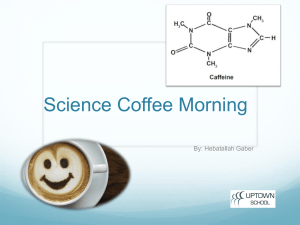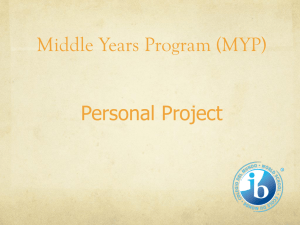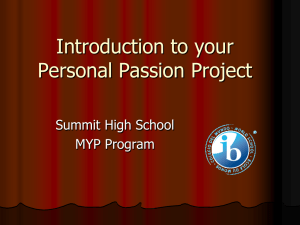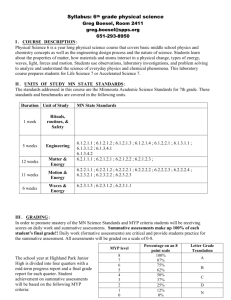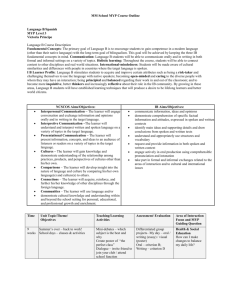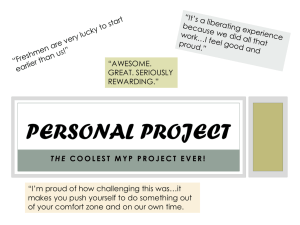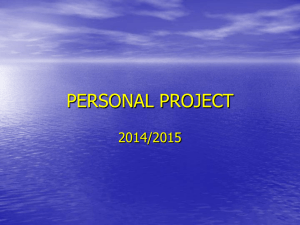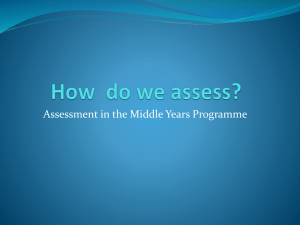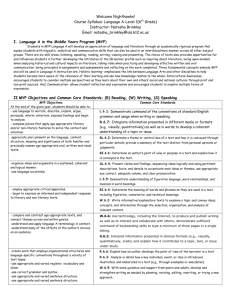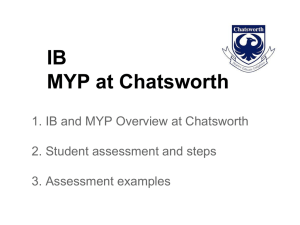MYP Assessment Criteria Each assessment criterion in every
advertisement
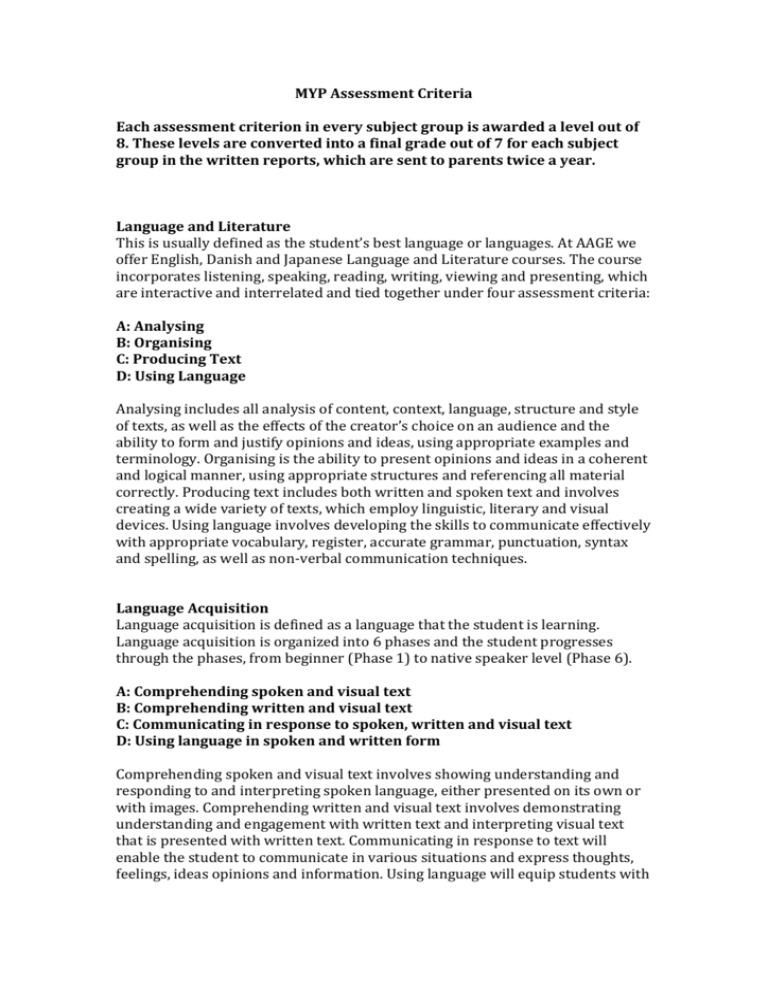
MYP Assessment Criteria Each assessment criterion in every subject group is awarded a level out of 8. These levels are converted into a final grade out of 7 for each subject group in the written reports, which are sent to parents twice a year. Language and Literature This is usually defined as the student’s best language or languages. At AAGE we offer English, Danish and Japanese Language and Literature courses. The course incorporates listening, speaking, reading, writing, viewing and presenting, which are interactive and interrelated and tied together under four assessment criteria: A: Analysing B: Organising C: Producing Text D: Using Language Analysing includes all analysis of content, context, language, structure and style of texts, as well as the effects of the creator’s choice on an audience and the ability to form and justify opinions and ideas, using appropriate examples and terminology. Organising is the ability to present opinions and ideas in a coherent and logical manner, using appropriate structures and referencing all material correctly. Producing text includes both written and spoken text and involves creating a wide variety of texts, which employ linguistic, literary and visual devices. Using language involves developing the skills to communicate effectively with appropriate vocabulary, register, accurate grammar, punctuation, syntax and spelling, as well as non-verbal communication techniques. Language Acquisition Language acquisition is defined as a language that the student is learning. Language acquisition is organized into 6 phases and the student progresses through the phases, from beginner (Phase 1) to native speaker level (Phase 6). A: Comprehending spoken and visual text B: Comprehending written and visual text C: Communicating in response to spoken, written and visual text D: Using language in spoken and written form Comprehending spoken and visual text involves showing understanding and responding to and interpreting spoken language, either presented on its own or with images. Comprehending written and visual text involves demonstrating understanding and engagement with written text and interpreting visual text that is presented with written text. Communicating in response to text will enable the student to communicate in various situations and express thoughts, feelings, ideas opinions and information. Using language will equip students with the ability to organize their material in a coherent way, both in spoken and written form and learn to use the target language accurately. Mathematics The objectives and assessment criteria in MYP Mathematics are designed to equip students with the knowledge to use mathematics in a variety of contexts (including real-life situations), perform investigations and communicate mathematics clearly. Students should demonstrate knowledge and understanding of the concepts and skills of the four branches of mathematics; number, algebra, geometry and trigonometry, and statistics and probability. A: Knowing and Understanding B: Investigating Patterns C: Communicating D: Applying Mathematics in Real-Life Contexts Knowledge and understanding are fundamental to studying mathematics and form the base from which to explore concepts and develop skills. This objective assesses the extent to which students can select and apply mathematics to solve problems in both familiar and unfamiliar situations in a variety of contexts. Investigating patterns allows students to experience the excitement and satisfaction of mathematical discovery. The ability to inquire is central to the MYP and contributes to lifelong learning. Mathematics provides a powerful and universal language. Students are expected to use appropriate mathematical language and different forms of representation when communicating mathematical ideas, reasoning and language. MYP mathematics encourages students to see mathematics as a tool for solving problems in an authentic reallife context. Sciences MYP Sciences include Physics, Chemistry and Biology, which are delivered as an integrated Sciences course throughout the MYP. The sciences objectives and assessment criteria reflect the holistic nature of science and the real world work of scientists. They enable students to engage with all aspects of science, either through individual objectives or connected processes. A: Knowing and Understanding B: Inquiring and Designing C: Processing and Evaluating D: Reflecting on the Impacts of Science Criterion A measures students’ scientific knowledge (facts, ideas, concepts, processes, laws, principles, models and theories) and apply it to solve problems and express scientifically supported judgments. Criterion B measures intellectual and practical skills through designing, analyzing and performing scientific investigations. Although the scientific method involves a wide variety of approaches, the MYP emphasizes experimental work and scientific inquiry. For criterion C, students collect, process and interpret qualitative and/or quantitative data, and explain conclusions that have been appropriately reached, while for criterion D, students show global understanding of science by evaluating the implications of scientific developments and their applications to a specific problem or issue. Individuals and Societies Individuals and Societies includes subjects such as History, Geography, Economics, Philosophy, Psychology, Sociology, Political Science and World Religions. The course is delivered as an integrated course throughout the MYP. The assessment criteria reflect the knowledge, skills and attitudes that students need to understand in order to encourage the development of different domains of learning; they represent essential aspects of individuals and societies courses. A: Knowing and Understanding B: Investigating C: Communicating D: Thinking Critically Criterion A assesses the students’ factual and conceptual knowledge about individuals and societies, while criterion B assesses the students’ systematic research skills and processes associated with disciplines in the humanities and social sciences. Students develop successful strategies for investigating independently and in collaboration with others. Criterion C assesses students’ skills to organize, document and communicate their learning using a variety of media and presentation formats. Criterion D shows how students can use their critical thinking skills to develop and apply their understanding of the subject and the process of investigation. Arts The arts subjects studied at AAGE are Visual Arts, Music and Drama. Students study a balance of all the subjects throughout the programme. The assessment criteria for Arts apply across the subjects and emphasise both the theory and history of arts as well as practical application and evaluation. A: Knowing and Understanding B: Developing Skills C: Thinking Creatively D: Responding Criterion A assesses knowledge and understanding of the arts; students study theorists and practitioners and are able to analyse and communicate in specialized language. Criterion B assesses the acquisition and development of skills, providing the opportunity for active participation in arts and in the process of creating art. Skills are evident in both process and product. Criterion C assesses students’ ability to explore the unfamiliar and experiment in innovative ways to develop their artistic intentions, their processes and their work. Criterion D allows the students to show their ability to respond to art. Responding to art can come in many forms; creating art as a response encourages students to make connections and transfer their learning to new settings. Through reflecting on their artistic intention and the impact of their work on an audience and on themselves, students become more aware of their own artistic development and the role that arts play in their lives and in the world. Design Design at AAGE includes many different types of design-related subjects, including graphic design, digital design, resistant materials and aspects of architecture. The subject is compulsory in all years of the MYP. The assessment criteria highlight the importance of the Design Cycle in the MYP subject. A B C D Inquiring and Analysing Developing Ideas Creating the Solution Evaluating MYP design challenges all students to apply practical and creative thinking skills to solve design problems; encourages students to explore the role of design in both historical and contemporary contexts; and raises students’ awareness of their responsibilities when making design decisions and taking action. Inquiry and problem-solving are at the heart of the subject group. MYP design requires the use of the design cycle as a tool, which provides the methodology used to structure the inquiry and analysis of problems, the development of feasible solutions, the creation of solutions, and the testing and evaluation of the solution. In MYP design, a solution can be defined as a model, prototype, product or system that students have developed and created independently. Physical and Health Education PHE includes all forms of physical activities, encompassing a range of sports, including badminton, football, volleyball, hockey, basketball, fitness and many others. MYP PHE also includes some theory work that covers health, nutrition and fitness. A Knowing and Understanding B Planning for Performance C Applying and Performing D Reflecting and Improving Performance Physical and health education focuses on both learning about and learning through physical activity. Both dimensions help students to develop approaches to learning (ATL) skills across the curriculum. Physical and health education contributes a unique perspective to the development of the attributes of the IB learner profile, promoting the health of individuals and communities. Through physical and health education, students can learn to appreciate and respect the ideas of others, and develop effective collaboration and communication skills. This subject area also offers many opportunities to build positive interpersonal relationships that can help students to develop a sense of social responsibility. At their best, physical and health education courses develop the enjoyment, engagement and confidence in physical activity that students need in order to achieve and maintain a balanced, healthy life.
